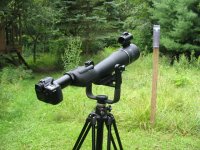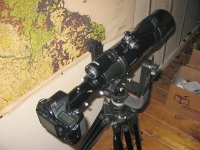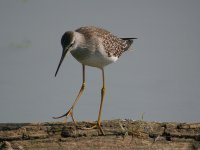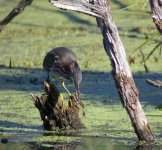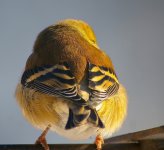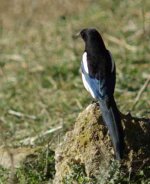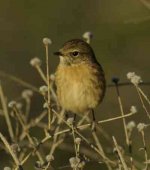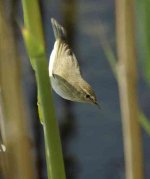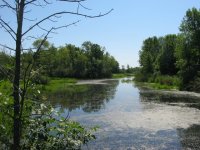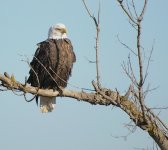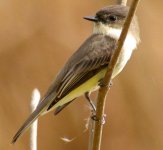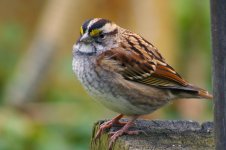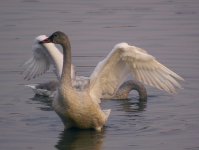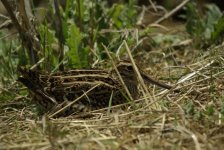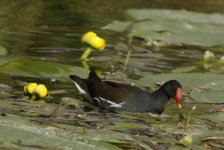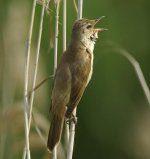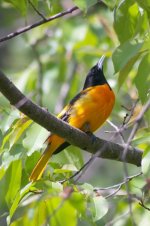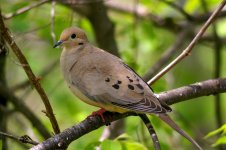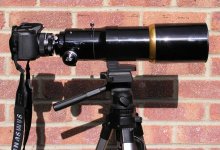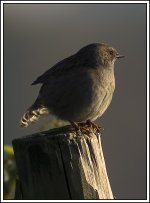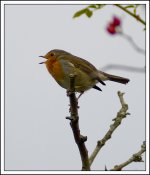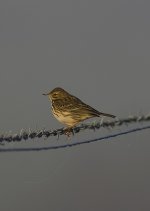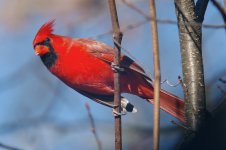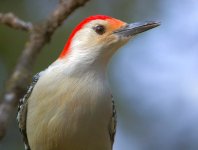-
Welcome to BirdForum, the internet's largest birding community with thousands of members from all over the world. The forums are dedicated to wild birds, birding, binoculars and equipment and all that goes with it.
Please register for an account to take part in the discussions in the forum, post your pictures in the gallery and more.
You are using an out of date browser. It may not display this or other websites correctly.
You should upgrade or use an alternative browser.
You should upgrade or use an alternative browser.
Birding with Pentax (1 Viewer)
- Thread starter Anavasi
- Start date
More options
Who Replied?impotentspider
Well-known member
I use both my Sigma 50-500 and my trusty old Pentax 80-320 for birding, the Sigma can be a bit of a handful and I often use a monopod or tripod, the 80-320 handles better, and dare I say performs much better for a lens that was a fraction of the cost of the Sigma. For macro work I use a Tamron SP 90mm which I have to say is every bit as good as any of the Pentax glass that I own or have owned in the past, I just wish I could get close enough to snap birds with it.
My other favourite glass is one that has a Stella Atrois logo on the side, preferably full B
Photos are in my gallery, no birds in there yet though.
My other favourite glass is one that has a Stella Atrois logo on the side, preferably full B
Photos are in my gallery, no birds in there yet though.
Last edited:
Anavasi said:Hi Pentaxians,
This part of the forum needs to see some action! Lets make an inventory of long glasses we are using more often for birds. Comment your most used lens and add a representative photo.
Regards
I use a Pentax *istDL setup just for birds. However I don't use a conventional telephoto long lens-they just are not practical for most wildlife photography in my opinon. Too large, clumsy, heavy and expensive and they don't give the magnification I really need.
Instead I use a Pentax 100mm (objective size not FL) spotter, a 80mm Pentax spotter and a 102mm Celestron astro scope setup for prime focus closeup photography. I do have a Sigma 70-300 zoom but it's never used for wildlife photography-mostly as a macro.
SF
Attachments
Last edited:
Sout Fork said:Instead I use a Pentax 100mm (objective size not FL) spotter, a 80mm Pentax spotter and a 102mm Celestron astro scope setup for prime focus closeup photography. I do have a Sigma 70-300 zoom but it's never used for wildlife photography-mostly as a macro.
SF
I am a more traditional photographer and a bit addicted to long lenses. So, I am afraid I spent more time hesitating on material and less on real life action. On the other side I was more focused on mountain birds, that are by default more difficult to approach, at least in the greek landscapes. So I was always looking for big glasses.
I never relized that spotters could give so clear images as your posts here. Indeed, the yellowleg (BTW, what is its taxonomic name ?) is a very nice frame. I do not have a spotter, just binoculars.
Anyway, I started with a Pentax M500 F4.5 attached to my LX back in the 80s, continued in the autofocus era with a Z1 and a Tamron 300F2.8. Now I use a K10D with a Bigma, by which I was positivelly surprized. And - age counting - I started to photograph in other environments too, outside mountains, where situation is easier. Last week I added a really big glass to my bag, a FA600F4. No photos yet.
Pica pica, K10D, M500F4.5, a lot of chromatic abberation
Saxicola rubetra, K10D, Tamron 300F2.8, good bokeh
Plylloscopus collibita, K10D, Sigma 50-500.
Attachments
Very pleased at this Pentax revival.
Having moved through a variety of cameras over the years ---Minolta Hi-Matic 7s, Minolta X700 with a multiplicity of lenses, Fuji APS zoom, and a Minolta DiMage A1 [which I still have], I now have a Pentax K100D with a Sigma 17-70mm f2.8-4.5 Macro DC and a Sigma 70-300mm f4-5.6 APO DG Macro.
On my limited budget, I find both of these lenses to be very good for the purpose for which they were designed. However, since I am a very casual, but enthusiastic, photographer of all subjects, I find, when out hiking, that I am forever changing the lens, since each one is unsuitable for the designed purpose of the other.
As an example, when I was hiking in the Cevennes this week, I was happily photographing lizards, wildflowers, rock formations and landscapes [W/A], when some vultures came soaring overhead, ----- resulting in a mad scramble to exchange the lens for the 70-300, by which time the vultures were moving elsewhere.
It occurs to me that the only solution which avoids this "scrambling", and the ingress of "dust", plus the possibility of a dropped lens, is to carry two cameras, each with its own lens, since the extra weight would only be that of the second body.
I also, of course, have to carry my rucksac, with food and water, and binoculars anyway.
Does anyone else use this as a solution to their problems?
I must explain that I am not a dedicated bird photographer, into sitting in a hide, awaiting those often elusive subjects, but do like to photograph them whenever the opportunity arises.
On a slightly different subject, I have been considering one of the second-hand 400mm f5.6 Sigma lense that sometimes turn up,[ light and handy], or else a Sigma 170-500 zoom, [bigger and heavier].
Can any one offer an opinion on choice of these please.
I do realise however, that whatever equipment one has, one will still have to seek out one's subjects. Birds will not come down specially to have a look at it, and I doubt whether I have the necessary patience to await their coming anyway.
Having moved through a variety of cameras over the years ---Minolta Hi-Matic 7s, Minolta X700 with a multiplicity of lenses, Fuji APS zoom, and a Minolta DiMage A1 [which I still have], I now have a Pentax K100D with a Sigma 17-70mm f2.8-4.5 Macro DC and a Sigma 70-300mm f4-5.6 APO DG Macro.
On my limited budget, I find both of these lenses to be very good for the purpose for which they were designed. However, since I am a very casual, but enthusiastic, photographer of all subjects, I find, when out hiking, that I am forever changing the lens, since each one is unsuitable for the designed purpose of the other.
As an example, when I was hiking in the Cevennes this week, I was happily photographing lizards, wildflowers, rock formations and landscapes [W/A], when some vultures came soaring overhead, ----- resulting in a mad scramble to exchange the lens for the 70-300, by which time the vultures were moving elsewhere.
It occurs to me that the only solution which avoids this "scrambling", and the ingress of "dust", plus the possibility of a dropped lens, is to carry two cameras, each with its own lens, since the extra weight would only be that of the second body.
I also, of course, have to carry my rucksac, with food and water, and binoculars anyway.
Does anyone else use this as a solution to their problems?
I must explain that I am not a dedicated bird photographer, into sitting in a hide, awaiting those often elusive subjects, but do like to photograph them whenever the opportunity arises.
On a slightly different subject, I have been considering one of the second-hand 400mm f5.6 Sigma lense that sometimes turn up,[ light and handy], or else a Sigma 170-500 zoom, [bigger and heavier].
Can any one offer an opinion on choice of these please.
I do realise however, that whatever equipment one has, one will still have to seek out one's subjects. Birds will not come down specially to have a look at it, and I doubt whether I have the necessary patience to await their coming anyway.
It sounds like you might want to consider going the spotter route if
you want high magnifications for those distant mountain shoots.
My 100mm spotter gives me about 40x. That would be the equivalent of a
1920mm fl prime lens- which, of course, would be impractical.
In my case I need this kind of magnification because I am often in
wilderness habitat where movement is very difficult if not impossible so
I need optics to allow me to get close. See pic
My setup require a special Pentax DSLR camera adaptor between the camera
and the scope (the long black tube you see in front of the camera in the
picture). Pentax part number CA-35. This is not just a passive extension
tube but is a five element ED glass device that cost about $400 here in
the States. My 100mm scope plus adaptor cost about $2000 US.
A few examples of distant shots with this setup. The eagle was a little
over half a mile distant. Of course they are all compressed down from 3-4 meg files so quality is not nearly as good as the originals.
The Lesser Yellowlegs is (Tringa flavipes)
SF
you want high magnifications for those distant mountain shoots.
My 100mm spotter gives me about 40x. That would be the equivalent of a
1920mm fl prime lens- which, of course, would be impractical.
In my case I need this kind of magnification because I am often in
wilderness habitat where movement is very difficult if not impossible so
I need optics to allow me to get close. See pic
My setup require a special Pentax DSLR camera adaptor between the camera
and the scope (the long black tube you see in front of the camera in the
picture). Pentax part number CA-35. This is not just a passive extension
tube but is a five element ED glass device that cost about $400 here in
the States. My 100mm scope plus adaptor cost about $2000 US.
A few examples of distant shots with this setup. The eagle was a little
over half a mile distant. Of course they are all compressed down from 3-4 meg files so quality is not nearly as good as the originals.
The Lesser Yellowlegs is (Tringa flavipes)
SF
Attachments
Last edited:
bestboat said:It occurs to me that the only solution which avoids this "scrambling", and the ingress of "dust", plus the possibility of a dropped lens, is to carry two cameras, each with its own lens, since the extra weight would only be that of the second body.
I also, of course, have to carry my rucksac, with food and water, and binoculars anyway.
Does anyone else use this as a solution to their problems?
..........
On a slightly different subject, I have been considering one of the second-hand 400mm f5.6 Sigma lense that sometimes turn up,[ light and handy], or else a Sigma 170-500 zoom, [bigger and heavier].
Can any one offer an opinion on choice of these please.
Hi Bestboat,
Yes, I thing that a 2-bodies solution is a good idea. Last days I worked with my K10D on the FA600F4 and a film body (MZ-S) on the Sigma 50-500, as I have not a second digital body. I found out that this combination gave me the flexibility to face all opportunities - small birds and next a gray heron, let say - without having to change lenses. But, i did not carry these monsters, I just drove in very low speed along the canals of a drained lake.
Backpacking is a different story. For 1-day trips, a second body is still a good idea, since the K100D is a very light camera. I did it sometimes, again with the K10D and the MZ-S, and I found it very practical, for the very reasons you recall (I usally attach a macro lens on the film body and the Sigma 50-500 to the digital).
Consernig the lenses, the 400F5.6 is a much better choice, as it is faster, lighter, min focusing distance is closer and image quality is better. Chasseur d' Image made a very clear comment on these lenses. I used an old 400F5.6 once and I found it decent, allthough I had the feeling of a cheep thing, which was the case with all non-EX Sigmas. On the negative side of the 170-500 you must add that F6.3 is a bit just for autofocusing.
But, the 100mm difference is very important for distant subjects, like birds (100mm=150mm for K100D). I am using a Sigma 50-500F6.3 and I have regularilly decent results, allthough due to the small aperture (6.3) there are some mistakes in autofocusing. So, I should suggest to forget the 170-500, as the 50-500 is much better build and has better optics and to decide between the two price tags (the Sigma 400 is much less expensive in the 2nd hand market).
Anyway, moving from the 70-300 to either the 400 or the 50-500 will mark a big step ahead in your photography.
And keep scrambling - but in the nature this time !!
Regards
Thanks for your advice Anavazi. I am going to try using a combination of my old digital Minolta A1, 28-200mm equivalent, which takes pretty reasonable Macro and landscape shots, and is light and relatively small, together with the K100D and a "long" lens for birds, and more distant objects.
Regards bestboat
Regards bestboat
New birds
Three new images from Greece. Spring is ongoing in Souther Greece and all species are getting more active. The Snipe is taken with K10D + Sigma 50-500 at a distance of 3.5 m. The Moorhen and the Great Reed Warbler with the FA* 600 F4.
Is there anyone else working with K10D ? What are your experience with SR turned ON when sitting the lens on a stable substrate (like a car window) ? I have mixed impressions.
Regards, Anavasi
Three new images from Greece. Spring is ongoing in Souther Greece and all species are getting more active. The Snipe is taken with K10D + Sigma 50-500 at a distance of 3.5 m. The Moorhen and the Great Reed Warbler with the FA* 600 F4.
Is there anyone else working with K10D ? What are your experience with SR turned ON when sitting the lens on a stable substrate (like a car window) ? I have mixed impressions.
Regards, Anavasi
Attachments
Spot Focus
Well-known member
Hi All:hi: I've just acquired a K10D I had a DS previously. lens wise I have sigma's 50-500 70-300 18-125 28-70 f2.8 :hi: Anavasi I have tried SR with a mono and haven't really noticed a difference except at really slow shutter speeds.Three new images from Greece. Spring is ongoing in Souther Greece and all species are getting more active. The Snipe is taken with K10D + Sigma 50-500 at a distance of 3.5 m. The Moorhen and the Great Reed Warbler with the FA* 600 F4.
Is there anyone else working with K10D ? What are your experience with SR turned ON when sitting the lens on a stable substrate (like a car window) ? I have mixed impressions.
Regards, Anavasi
Spot Focus said:
"Sout Fork your setup interests me greatly as I find 500mm a little short and slow f/stop wise and a pentax 600 f4 a little out of reach at $8000 odd I wonder if you could tell me what Aperture your 100mm scope is equivalent too"
About f12. However in fairness - Take that $8000+$500 600mm and a tele extender and you end up with a 16 pound monster (my spotter is 5.5 pounds) 36x that is about f11 at best. The point is ANY, say, f4 optical system at 40x is impractical. Too big, too heavy, too clumsy and too expensive.
There is no way you can have it all- speed, lightness, power, affordability at anything as high as 40x in my opinion.
Also in real world use I take all of my pictures between ISO 200-800. It works for me. Judge for yourself - see my posts.
SF
"Sout Fork your setup interests me greatly as I find 500mm a little short and slow f/stop wise and a pentax 600 f4 a little out of reach at $8000 odd I wonder if you could tell me what Aperture your 100mm scope is equivalent too"
About f12. However in fairness - Take that $8000+$500 600mm and a tele extender and you end up with a 16 pound monster (my spotter is 5.5 pounds) 36x that is about f11 at best. The point is ANY, say, f4 optical system at 40x is impractical. Too big, too heavy, too clumsy and too expensive.
There is no way you can have it all- speed, lightness, power, affordability at anything as high as 40x in my opinion.
Also in real world use I take all of my pictures between ISO 200-800. It works for me. Judge for yourself - see my posts.
SF
Spot Focus
Well-known member
Spot Focus said:
"Sout Fork your setup interests me greatly as I find 500mm a little short and slow f/stop wise and a pentax 600 f4 a little out of reach at $8000 odd I wonder if you could tell me what Aperture your 100mm scope is equivalent too"
About f12. However in fairness - Take that $8000+$500 600mm and a tele extender and you end up with a 16 pound monster (my spotter is 5.5 pounds) 36x that is about f11 at best. The point is ANY, say, f4 optical system at 40x is impractical. Too big, too heavy, too clumsy and too expensive.
There is no way you can have it all- speed, lightness, power, affordability at anything as high as 40x in my opinion.
Also in real world use I take all of my pictures between ISO 200-800. It works for me. Judge for yourself - see my posts.
SF
I realize the trade offs involved :C thats why I have a 50-500 f6.3 not a 500 or 600 f4
I realize the trade offs involved :C thats why I have a 50-500 f6.3 not a 500 or 600 f4I am impressed with the images from your setup. The 50-500 with a 2x is about f11 and I doubt it is as good as your setup
I think what I was trying to get at was that I see so many posts asking about what size telephoto would they need for wildlife photography. The fact is none. The longest practical focal length in a conventional prime lens tele is 500mm which gives you 15x in DSLR.
At 15x you are just at the bottom of the power range for wildlife photography and you go up from there. Sure if you had a blind and a lot of time you could get some decent work done. But what about most photos which are photos of opportunity where you have no option but to take photos where you happen to be at the time?
Another few photos taken with this setup just yesterday..
Take care
Sparrow
Attachments
doug_newman
Well-known member
I would love to get my hands on a 300mm F2.8 Pentax lense but $4700 is quite steep.
inenhiol
Member
having sold a 400d / 100-400 L is To afford the cost of a kowa tsn 83 ( digiscoping ! ), I still needed a dslr system for moving birds. I briefly dabbled with the k100d , then got a k10d for the FAST af. I couldn't get a 100-400 sigma pentax for love or money but I did find a 170-500 and i'm getting there, even compared to the 100-400 is
with the kenko 2x the 170-500 stiff autofocuses ( I've got a kenko 1.5 and the 2x )
cormorans don't mind the mirror/shutter noise of the pentax k10d
there are a number of shooting opportunities here in Brittany ( marshes in the Lorient of vannes areas, rivers like the Blavet, and the endless shoreline itself of course
I'm finding the k10d need an awful lot of tweaking but i've always love a challenge. Also the noise suppressing algorhythms tend to erase to much detail, I think I'll do without them. The stabilizer does work on the longer focals
when using the 170-500, there's a weird bug that will at times make the lcd display vanish altogether too fast ( 1 sec at times ) this doesn't happen with the 50-200 sigma or other lens
could be a sigma chip something though
If I find how to add pictures to my replies I shall do so...
As it is, it's a pleasure reading about pentax users and their world
with the kenko 2x the 170-500 stiff autofocuses ( I've got a kenko 1.5 and the 2x )
cormorans don't mind the mirror/shutter noise of the pentax k10d
there are a number of shooting opportunities here in Brittany ( marshes in the Lorient of vannes areas, rivers like the Blavet, and the endless shoreline itself of course
I'm finding the k10d need an awful lot of tweaking but i've always love a challenge. Also the noise suppressing algorhythms tend to erase to much detail, I think I'll do without them. The stabilizer does work on the longer focals
when using the 170-500, there's a weird bug that will at times make the lcd display vanish altogether too fast ( 1 sec at times ) this doesn't happen with the 50-200 sigma or other lens
could be a sigma chip something though
If I find how to add pictures to my replies I shall do so...
As it is, it's a pleasure reading about pentax users and their world
Paul Corfield
Well-known member
This is my long lens set up. It's a Samsung GX-1L camera which is a clone of the Pentax *ist DL2. That's mounted to a 2X teleconverter which is in turn mounted to a t-mount which has a 1.25" nosepiece which then goes into the scope. The scope is a William Optics 80mm ZenithStar semi apo rated at F6. Basically a good quality achromat. Focal length is 480mm so converted to 35mm format that's equivalent to 720mm and with the 2X teleconverter thats 1440mm. I can focus from infinity down to around 6m. All I need to get now is a William Optics 2" VR-1 filter which will remove virtually all purple fringing, improve sharpness/contrast and take it to near apo quality. The scope cost £225 new just a month ago and I'm very pleased with the price/image quality. Here's some pics, one of the set up and some birds taken with it.
Paul.
Paul.
Attachments
This is my long lens set up. It's a Samsung GX-1L camera which is a clone of the Pentax *ist DL2. That's mounted to a 2X teleconverter which is in turn mounted to a t-mount which has a 1.25" nosepiece which then goes into the scope. The scope is a William Optics 80mm ZenithStar semi apo rated at F6.
Paul,
I wonder if you have considered using a barlow instead of a teleconverter in that astro scope?
Because a telephoto already has negative focus group in the rear of the lens a teleconverter is made to correct for this group. On an astro scope at prime focus no such group is present.
Because of this you might want to try to use a barlow in place of the teleconverter. It MIGHT, and I'm not sure, give better performance in an astro scope than a teleconverter which is made to correct for a conventional telephoto lens.
In any case a barlow is cheap and wouldn't cost a lot to try one out on your setup.
SF
A few shots taken with an 80mm Astro-Tech APO triplet with a 2x barlow.
Attachments
Similar threads
- Replies
- 21
- Views
- 1K
Users who are viewing this thread
Total: 2 (members: 0, guests: 2)




